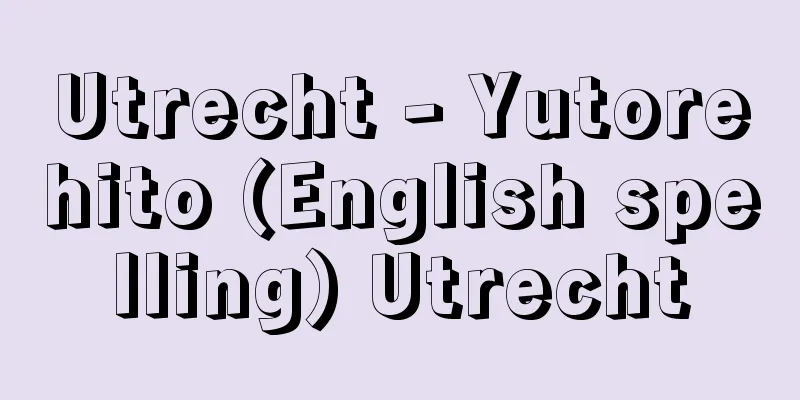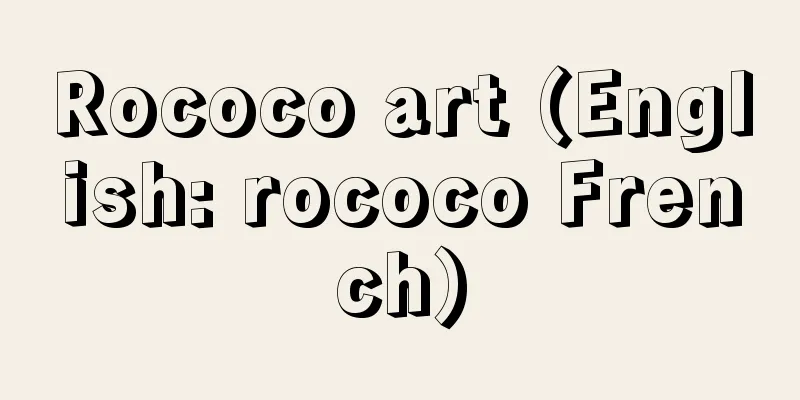Utrecht - Yutorehito (English spelling) Utrecht

|
The capital of the province of Utrecht in the center of the Netherlands, it is a commercial and industrial city with a population of 256,420 (2001). Located along the Vecht River, a tributary of the Rhine, it is the base of domestic commerce as well as a transportation and cultural center. In addition to traditional textiles, pottery, and tobacco, metal, machinery, chemicals, and printing industries have developed, but the main industries are commerce and services, and international industrial fairs are held in spring and autumn, as well as long-standing fruit and vegetable markets and cattle markets. It is also a transportation hub where the Amsterdam-Rhine Canal, railways, and highways converge, and is the location of the headquarters of the national railway. The old town is surrounded by a deep moat, and in the center there are the Dom Church with its 112-meter-tall Gothic spire, as well as numerous museums and vocational schools, including the Railway Museum, and the State University of Utrecht (founded in 1636) on the outskirts, making it an academic and cultural city. After the Second World War, the population increased rapidly, leading to the expansion of the city into the suburbs and the promotion of redevelopment projects in the old city center, centered on the central station, known as the Hohe Katerina Plan. The province of Utrecht is located south of the IJsselmeer and is the smallest province with a total area of 1,434 square kilometres and a land area of 1,359 square kilometres, with a population of 1,117,997 (2001). Most of the province lies on the Rhine delta, but as the southern limit of the Scandinavian ice sheet crosses the province in a northwest-southeast direction, the eastern part is barren gravel land and the western part is fertile clay land, with dairy farming and the cultivation of wheat and vegetables taking place mainly on the latter. The province originated from a bishopric founded by Saint Willibrord in 722. [Takaharu Hasegawa] historyThe name means "downstream ford" and in Roman times it was called Trajectum or Ultrajectum, and was a fortification that protected the northern border of the Roman Empire. The Frankish king appointed Willibrord bishop in 695 to evangelize the Frisians who had once conquered this area, and later established a bishopric with Willibrord as its first bishop. Since then, it has developed as a city to prevent the invasion of pagans, and from the 9th century onwards it became the commercial center of the Northern Netherlands, and the textile industry developed, reaching its peak in the 11th and 12th centuries. At the end of the 13th century, trade declined due to political conflicts and the rise of other cities, but the textile industry continued to survive. In 1304, the rights of the guilds of the same profession were recognized, but this caused discord with the bishop, who was not happy with the strengthening of autonomy, and the citizens were oppressed. In 1528, the bishopric was sold to Holy Roman Emperor Charles V. During the reign of Philip II (1556-1598), the city supported William of Orange and played an important role in the Dutch independence movement, becoming the site of the Union of Utrecht in 1579. Its cosmopolitan character is also evident in the Treaty of Utrecht of 1713. [Yoneda Kiyohiro] World Heritage RegistrationThe Schröder House, designed and built in 1924 by the Dutch architect Gerrit Rietveld, is located in the city of Utrecht, and in 2000 it was registered as a World Heritage Site by UNESCO (United Nations Educational, Scientific and Cultural Organization) as the "Schröder House designed by Rietveld." [Editorial Department, May 21, 2018] [References] | |Source: Shogakukan Encyclopedia Nipponica About Encyclopedia Nipponica Information | Legend |
|
オランダ中部、ユトレヒト州の州都で、商工業都市。人口25万6420(2001)。ライン川支流のベヒトVecht川に沿い、国内商業の拠点であると同時に、交通・文化の中心地でもある。伝統的な繊維、陶器、たばこのほか、金属、機械、化学、印刷などの工業が発達するが、主産業はむしろ商業、サービス業にあり、古くからの青果市、牛市をはじめ、春と秋には国際産業見本市が開催される。またアムステルダム・ライン運河や鉄道、高速道路が集中する交通の結節点でもあり、国鉄本社の所在地となっている。旧市街は深い堀によって囲まれ、中心部には高さ112メートルのゴシック様式の尖塔(せんとう)を有するドム教会をはじめ、鉄道博物館など多数の博物館、専門学校があり、郊外にあるユトレヒト州立大学(1636創立)を含めて、学術文化都市としての性格も有する。第二次世界大戦後に人口が急増したため、郊外に市域が拡大し、またホーヘカテリナ計画とよばれる中央駅を中心とした旧市内の再開発事業が推進された。 ユトレヒト州はアイセル湖の南に位置し、総面積1434平方キロメートル、陸地面積1359平方キロメートルと最小の州で、人口111万7997(2001)。州域の大部分がライン川デルタの上にあるが、スカンジナビア氷床の南限が北西―南東方向に州を横断しているため、東部は砂礫(されき)質の不毛地、西部は粘土質の肥沃(ひよく)地となり、後者を中心に酪農と麦類・野菜の栽培が行われる。722年に聖ウィリブロルドが設立した司教区が州の起源である。 [長谷川孝治] 歴史名称は「下流の徒渉場」の意味で、ローマ時代にはトライェクトゥムTrajectum、ウルトライェクトゥムUltrajectumとよばれ、ローマ帝国北辺境を守る堡塁(ほうるい)であった。フランク王は、一時この地を征服したフリース(フリジア)人に対する宣教のため、695年ウィリブロルドを司教に任じ、のち司教区を設けて彼をその初代司教とした。以来異教徒の侵入を阻む都市として発展したが、9世紀以後は北ネーデルラントの商業の中心地となり、また織物業が発達し、11、12世紀にはこの都市の繁栄は最盛期を迎えた。13世紀末、政治的紛争と他都市の勃興(ぼっこう)により交易は衰えたが、織物業はなお存続した。1304年同職ギルドの権利が認められたが、これが自治権の強化を喜ばない司教との不和をよび、市民は弾圧された。1528年、司教は神聖ローマ皇帝カール5世に司教領を売却した。フェリペ2世(在位1556~1598)の時代には、オラニエ公ウィレムを支援し、オランダ独立運動において重要な役割を果たし、1579年ユトレヒト同盟結成の舞台となった。その国際的都市としての性格は、1713年のユトレヒト条約にもみられる。 [米田潔弘] 世界遺産の登録オランダ人建築家ヘリット・リートフェルトが1924年に設計・建築したシュレーダー邸はユトレヒト市内にあり、2000年、ユネスコ(国連教育科学文化機関)により「リートフェルト設計のシュレーダー邸」として世界遺産の文化遺産(世界文化遺産)に登録された。 [編集部 2018年5月21日] [参照項目] | |出典 小学館 日本大百科全書(ニッポニカ)日本大百科全書(ニッポニカ)について 情報 | 凡例 |
<<: Utrecht Psalter - Utrecht Psalter
Recommend
Yubetsu River
It flows through northeastern Hokkaido and emptie...
Bahā' al-Din Naqshband (English spelling)
...The group was founded by Abd al-Khāliq Ghujduw...
Sunset - Higure
This is the time when the depression angle of the...
Skill - Skill
...Population: 1900 (1989). Russians call them Ud...
Rice-growing culture area
...The term is often used to refer to the cultura...
Vecia villosa (English spelling)
…【Hoshikawa Kiyochika】. … *Some of the terminolog...
Gyele Loop
(Karl Gjellerup) Danish author. He started out as ...
Kikujido - Kikujido
The title of a Noh piece. The fourth piece. Author...
Forensics Division - Kanshikika
The Criminal Investigation Bureau is a branch of t...
Red Rock
...In 1979, the Kurakake Second Industrial Park w...
Anthracene oil - anthracene oil
A fraction obtained by distilling coal tar at 300...
Boston, LM (English spelling) BostonLM
...C.S. Lewis dealt with issues of good and evil ...
Odocoileus hemionus columbianus (English spelling) Odocoileushemionuscolumbianus
…[Yoshiharu Imaizumi]. … *Some of the terminology...
《Sisyā Darsan》(English spelling) SisyaDarsan
...28 Sanskrit documents, 40 Hindi documents, and...
Hong Gai - Hong Gai (English spelling)
The capital of Quang Ninh Province in northern Vi...




![Mountain country [town] - Yamakuni](/upload/images/67cd0dd87e0b0.webp)




